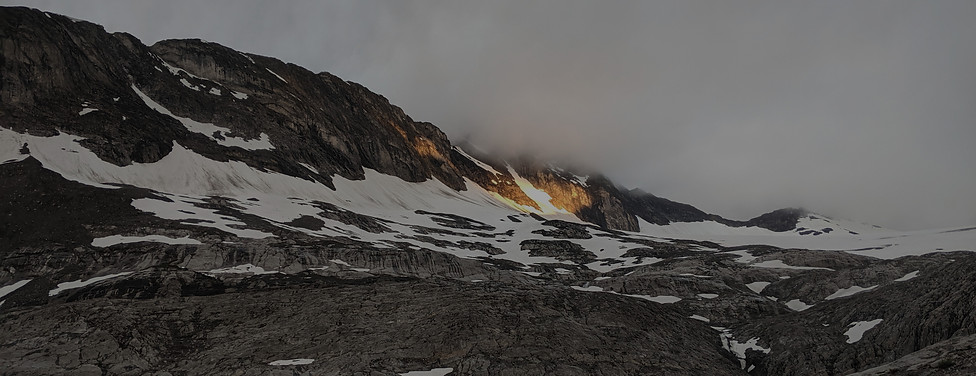
Implementing the Teaching Quality Standard
What follows is a collection of artefacts that demonstrate some ways I have delivered the Alberta Teaching Quality Standards in my practice as an educator.
TQS 1: Fostering effective relationships
“A teacher builds positive and productive relationships with students, parents/guardians, peers and others in the school and local community to support student learning.”
Artefact: Adios activity
Reflection:
What I have called the "adios activity" is essentially a student ratings of instruction document that I provide to students at then end of my time teaching them so that they may have a meaningful opportunity to support their own learning. I ask students what worked well for them and what didn't; how my teaching furthered their learning and what I should do differently. Though I encourage students to be honest and kind in their feedback, I have nonetheless been nervous when sitting down to read their comments. These nerves always dissipate as I experience the thoughtfulness, respect, care, and constructiveness with which students respond. These moments of dialogue, though anonymous, always feel like a confirmation of the productive relationship of trust and support that I build with my students. Furthermore, these students reflections always confirm or build upon the advice that partner teachers and other professional mentors have given me.
Post script: excuse the folded paper in the image above. We had used this scrap paper earlier in an activity to explore how the assembly line has streamlined production (in this case the production of paper airplanes) but potentially alienated workers from their labour.
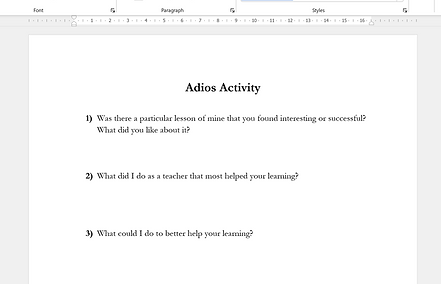

TQS 2: Engaging in career-long learning
“A teacher engages in career-long professional learning and ongoing critical reflection to improve teaching and learning.”
Artefact: Notes from University of Calgary experiential learning "nature walk" at Barrier Lake Field Station
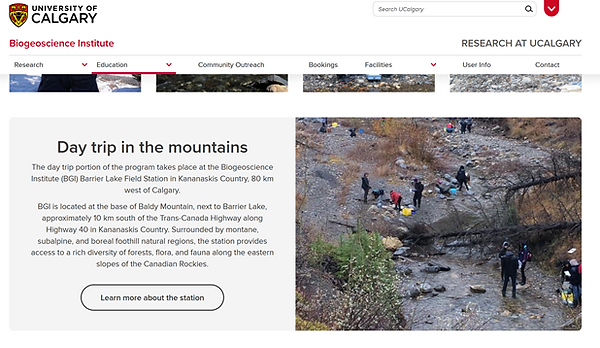

Reflection:
Of all the professional growth opportunities I have participated in, this nature walk offered by the Barrier Field Station and the University of Calgary in 2021 was most memorable. This workshop, led by School Program Coordinator Sue Arlidge, sought to build capacity in teachers who seek opportunities and abilities to lead land-based interdisciplinary lessons in order to improve their teaching practice. In the session we pre-service teachers learned how to support student learning across disciplines by accessing current environmental research, and how to empower students to become investigators of their environments. Sue Arlidge further explained how, with appropriate teacher guidance, students that often feel isolated or marginalized have unique opportunities to feel welcome and cared for in an outdoor environment. A starting point for any outdoor learning experience is assuring an inclusive and safe environment, and in this workshop we were taught how to prepare students for terrain and weather conditions, were taught how to inspect a field site before a class visit, and the importance of an emergency action plan. This workshop aligned closely with my own interests and inspired a flurry of ideas to implement with future classes.
TQS 3: Demonstrating a professional body of knowledge
“A teacher applies a current and comprehensive repertoire of effective planning, instruction, and assessment practices to meet the learning needs of every student.”
Artefact: Social Studies 30-1 "New Deal Projects" research and writing assignment
Reflection:
In this series of lessons and tasks, students are invited to explore the history and legacy of Franklin Delano Roosevelt's New Deal social welfare programs implemented throughout the 1930's and 1940's. Following an opening presentation and discussion on the subject led by the teacher, students are provided with a comprehensive database listing and describing hundreds of varied public works projects implemented by various government agencies under FDR. Students are offered the choice of what project to investigate according to whatever they find relevant and engaging.
Students in the class researched the impact of FDR's New Deal programs through specific events and structures that aligned with their interests. For instance, several skiers in the class focused on several ski resorts constructed and improved under the New Deal; one student with a passion for live music investigated the construction of one of his favourite outdoor venues, the Red Rock Amphitheatre; another student discovered that her favourite artist (of whose work her family owns several prints) was employed to create public pieces of art by a New Deal agency. So long as they demonstrated an understanding of academic citation practices, students were encouraged to present their research and achievement of the learning outcomes in a variety of methods according to whatever best suited their chosen project and their own skills and abilities. For instance, one student centred their research around folk singer Woody Guthrie's own experience working on a hydroelectric dam in Washington state as part of a public employment campaign. While some students were content to present a straight forward collection of quotes and other findings, this student submitted an unconventional but successfully cited slideshow that told the story of the project through Guthrie's life and music--the viewer scrolled through the student's research while being serenaded by one of Guthrie's tracks glorifying the working man.
TQS 4: Establishing inclusive learning environments
“A teacher establishes, promotes and sustains inclusive learning environments where diversity is embraced and every student is welcomed, cared for, respected and safe.”
Artefact: Simulated lesson plan and Individualized Program Plan created for University of Calgary course Educ445
Reflection:
Me and a group of my peers created both these documents while completing a course on the theories and application of individual learning. The first document describes how when presented with group of students with diverse learning needs (varying from English language learning to giftedness to an array of physical and developmental disabilities) we would employ Appropriate universal, targeted, and essential strategies and supports to address students’ strengths, learning challenges and areas for growth. Included in this document is a sample lesson plan that has Universal Design Learning principles at its core to ensure multiple angles of engagement by which a variety of students with diverse strengths and and challenges can have a successful learning experience.
The second document is another collaborative project from a University of Calgary course. Given a student description, me and a group of peers created a ten-page IPP for a fictional student. What I found most useful from this project was learning how to create very structured and bounded goals for a single student. In order to meet these goals, we also had to identify the student's greatest needs in order to be included and embraced in the learning environment, then finally we crafted accommodations to match each need and help reach our goals..
TQS 5: Applying foundational knowledge about First Nations, Métis, and Inuit
“A teacher develops and applies foundational knowledge about First Nations, Métis and Inuit for the benefit of all students.”
Artefact: Visual essay from University of Calgary course Educ530 and subsequent action
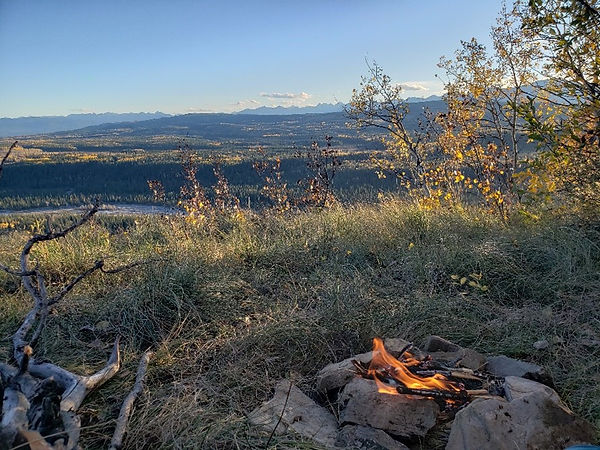
Reflection:
In a visual essay created for an Indigenous learning course at the University of Calgary, I explain the need I feel to foster personal and positive relationships with members of the Indigenous community near where I live, and where many of my students come from. In the essay I state, "As I sat reflecting on the landscape, the Ghost River flowed from right to left below me. The water marks the boundary between the Ghost Public Land Use Zone and the Îyârhe (Stoney) Nakoda reserve. In that moment, as it does now, the river appeared as a boundary between myself and Indigenous people. It formed the edge between Indigenous and Settler worlds and worldviews. This border occupies my thought as I look toward my teaching practise." In the essay I conclude with a demand on myself to begin the work of building these personal relationships.
Subsequently, I have joined two other teachers at my placement school in a meeting with a local elder, Mr. Hunter, to learn more about their cultural practices and the experiences of their students in a school dominated by non-Indigenous students and staff. Our goal is to better understand these communities and the needs of their young people so that we may develop and apply foundational knowledge about First Nations communities responsibly and authentically in an Aboriginal Studies course being offered next semester. We heard many stories from Mr. Hunter that will inform our teaching. We look forward to hearing more in our coming meetings.
TQS 6: Adhering to legal frameworks and policies
“A teacher demonstrates an understanding of and adherence to the legal frameworks and policies that provide the foundations for the Alberta education system.”
Artefact: Communication with partner teacher regarding student responsibilities under the Alberta Schools Act
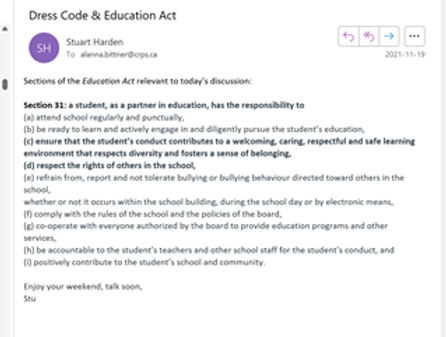
Reflection:
An awareness of the provincial Schools Act allowed me to contribute in a small way to a staff meeting regarding the increasing discomfort felt by staff and some students around the kind of clothing worn by a portion of the student population. When trying to find an effective way of framing the problem, I offered--in accordance with the legislation--that instead of defining this as a students versus staff problem, perhaps it should more properly be understood as an issue of respect and care between students. Indeed, the law states that every student must ensure that their "conduct contributes to a welcoming, caring, respectful and safe learning environment that respects diversity and fosters a sense of belonging." Perhaps, I suggested, students could be better convinced to alter their clothing and behaviour out of a sense of care and community with their peers.
Connect
Each of these artefacts represent effort and growth in my journey to becoming a teacher. I am proud of how they demonstrate my ability to take the theory and thought from the university classroom and apply these ideas to real-life contexts. In particular, my experiences implementing standards 1, 2, 3, and 5 have added a human dimension to the TQS, which otherwise is just a simple document. Crucially, I see that these standards are most useful as tool for improving the work I do as a teacher rather than simply assessing it. This is apparent as I reflect on the artefacts I selected, which seemed to me the strongest products of my time as a pre-service teacher. The adios activity, the nature walk, the meeting with elder Hunter, all of these instances where I was striving to evolve as a professional and as a person are the artefacts that matter most to me.
In pausing to connect these artefacts and standard with my life, I see a continuing need for me to understand how individualized instruction really works in the classroom. Indeed, my partner teacher identified this as an area of growth that I need to address in the coming field placement. I hope to at least work with if not create an IPP soon. Furthermore, though I have made a start at this I hope to be more methodical about the kinds of strategies and technologies I can incorporate into my lessons to make them more universally accessible to a wide range of student interests, strengths, and needs.